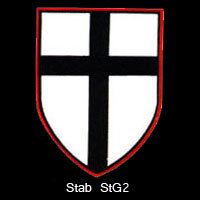Active 1943–45 Size Air Force Wing Founded 1943 | Nickname(s) Immelmann | |
 | ||
Similar Schlachtgeschwader 1, Sturzkampfgeschwader 2, Lehrgeschwader 1, Kampfgeschwader 4, Lehrgeschwader 2 | ||
Schlachtgeschwader 2 (SG 2) Immelmann was a Luftwaffe Dive bomber-wing of World War II. It was named after Max Immelmann, the first German pilot to earn the Pour le Mérite.
Contents
This close-support Stuka unit fought principally in the southern sector of the Eastern Front in places like Stalingrad and the Caucasus. The early two Schlachtgeschwader 1 and 2 were abbreviated SchlG, the reformed Stukageschwader in 1943 were abbreviated SG. The 4 SchlG Gruppen were integrated into the former Stuka (StG) and Schnellkampfgeschwader (SKG) to form SG 2, 4, 77 and 10.
History
Schlachtgeschwader 2 "Immelmann" was formed on 18 October 1943 from Sturzkampfgeschwader 2. I./SG 2 was I./StG 2, II./SG 2 was created from the II./Schlachtgeschwader 1, III./SG 2 was II./StG 2.
In 1941, Stukageschwader 2 was transferred to the Eastern Front. On 26 June 1941, Stuka Geschwader 2 attacked 60 Soviet tanks south of Grodno, and later discovered that only one T-34 had been knocked out. During the rest of 1941 and 1942, the inadequacy of dive-bombing tanks became more evident. The most effective way to assault tanks from the air would appear with SG 2 in 1943.
On 23 September 1941, StG 2 attacked the Baltic Red Banner Fleet docked in Kronstadt harbour. During the attack, Oblt. Rudel crippled the soviet Battleship Marat with a 1000 kg bomb.
In late 1942, a Panzerjäger Staffel was formed within StG 2, which enjoyed such success that, after October 1943, a similar unit was added to each Stuka Geschwader. During the spring of 1943 SG 2 worked up with modified Ju87 G-1 'tank-busters' armed with two Rheinmetall-Borsig 37mm Flak 18 guns mounted under each wing. Prototypes were first used against Russian landing craft in the Black Sea area. In March 1943 Rudel knocked out the first tank with the new Stuka. The Ju87 G-2, based on the Ju87 D-5 with extended wingtips, replaced the Ju87 G-1 during 1944. This was a dedicated tank-buster, with no secondary dive-bombing role.
On 14 April 1943, Rudel was awarded the Oakleaves to his Knights Cross. SG 2 developed new tank-assault tactics, having found the best way to destroy tanks was to attack them from the rear or flanks.
Stab, I. and II. Gruppe SchlG 2, which was a completely different Geschwader and should have its own wiki page, all saw service over Tunisia, with all component Gruppen and Stab operating Bf 109E and F Jabo (fighter-bomber) versions. SchlG 2 later mostly formed SG 4.
While II./SG 2, formerly II./SchlG 1, had been equipped with Focke Wulf Fw 190 since late 1942, I./SG 2 was converted to the new machine in June 1944. III./SG 2 kept on flying the outdated Junkers Ju 87 until the end of World War II.
By early 1944 II./SG 2 was covering the gradual Wehrmacht withdrawal around Kirovograd with II./JG 52.
As one of only two F w190 equipped ground-attack gruppen on the Eastern Front, II./SG 2 was heavily involved in the 6-month Crimean campaign during 1944, and in addition to its usual ground-attack work flew numerous interception sorties, claiming some 247 Soviet aircraft shot down. Leutnant August Lambert claimed some 70 kills during one 3 week period.
By May 1944 the depleted II./SG 2 withdrew to Romania.
By April 1945 Stab and II./SG 2 were based at Kummer, in northern Bohemia, while I./SG 2 was in Austria, and III./SG 2 near Prague.
At the end of the war, the commanding officer and a few other pilots flew their aircraft west and surrendered to the American forces. The transport column traveling on roads was destroyed.
